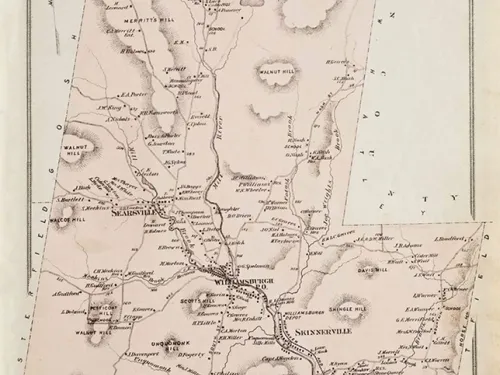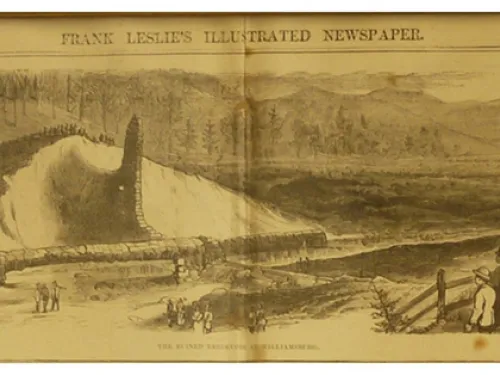Williamsburg Reservoir Dam (Massachusetts, 1874)
The Mill River Valley and 1800’s Industry
The Mill River in western Massachusetts typified the New England hydrologic resources used by 19th century industry, and the valley development was like that along hundreds of other rivers around New England. The river is a tributary of New England’s largest river, the Connecticut, intersecting that river from the west at the city of Northampton. To reach the Connecticut, the Mill River, drops 1100 feet in elevation over a relatively short distance of 15 miles, resulting in a steep river grade and a narrow valley. Parts of the valley are so narrow that they are described as a gorge and have room for only the river and a road. The valley villages were sited along the river in flatter flood banks, which extended only a few hundred feet to the confining valley hills. The river valley broadens greatly when it reaches the upper edges of the Connecticut River valley at Florence Meadows, just above Northampton.
In 1864, the force of gravity pulling water through mill races powered sixty-four factories staffed by about 1,500 workers in the mill towns of Williamsburg, Skinnerville, Haydenville, Leeds, and Florence clustered on the banks of the river. These factories produced brass fittings, iron tools, buttons, silk, wool, cotton, and tobacco products and supported a populace of about 5,000.
The Williamsburg Reservoir Company and Dam
The industrialists responsible for the Mill River manufacturing cluster came from relatively modest means and lived in the Mill River communities where they served as the local leaders and demonstrated a loyalty to the communities and to the well-being of their fellow residents. They knew that they benefitted from a shared resource – the river, which required cooperative use as water releases powered each factory in succession down the valley. They knew that more water storage would benefit them all.
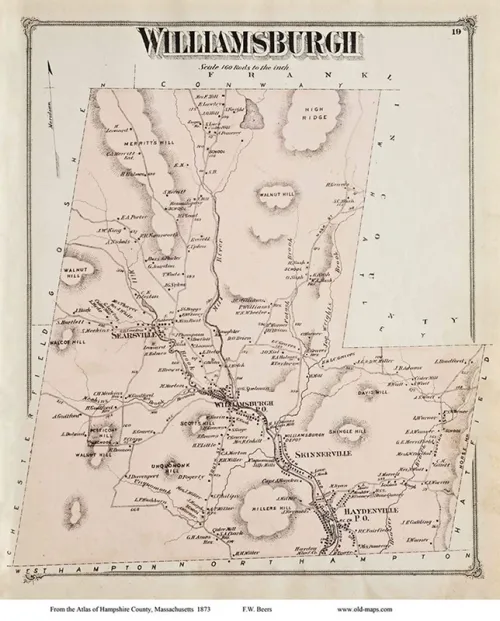
In 1864 eleven major factory owners identified a reservoir site on the East Branch of the Mill River above Williamsburg and organized the Williamsburg Reservoir Company, which was chartered by the Legislature in 1865. With their incorporation, the state empowered the reservoir company to proceed with the plan to build a dam at a location chosen by Joel Hayden, Sr., the most prominent and successful of the industrialists. No additional regulatory requirements existed for engineering, construction, involvement of the local communities, or follow-up inspections.
The Design
The reservoir company hired a series of designers to get a design that would match their construction budget of $30,000. They eventually retained Lucius Fenn. Fenn had no experience designing dams but was known to the owners because of his work surveying the local railroad. The final specifications called for an embankment with 1.5H:1V slopes and a rubble (uncut) stone masonry core wall founded in a 3-foot-deep trench with a tapered width (1H:12V sides) from 2 feet at the top to about 6 feet at its lowest level. Within 5 feet of the core wall, the embankment was to be placed in thin lifts, which were to be “wet and tamped or beaten with a maul.” Outside of these zones, the embankment would consist of earth, free from organic material, placed in compacted 5-foot-thick lifts. An 18-inch-diameter iron pipe set on a masonry wall would be the main outlet and would be controlled with a valve on its downstream end. The crest width was set at 16 feet and the dam height at 43 feet.
The Construction
A construction company owned by two partners, Emory Wells and Joel Bassett, responded to an ad by the reservoir company and proposed a price of $22,000. Wells and Bassett had constructed two mill dams, neither of which was of the scale proposed for the Williamsburg Reservoir. The reservoir company accepted the proposal and construction started on July 15, 1865. Construction would take only 6 months.
Issues with construction included failure to reach hardpan on the west side, reduction of the outlet pipe size, and illness and frequent absence of the inspector hired by the reservoir company. The core wall was founded on a sand and gravel layer at the reservoir company’s direction, despite concerns raised by the contractor. Embankment soil was placed in 2-foot-thick puddled (wetted) lifts near the core wall and in 5-foot-thick lifts elsewhere. Coverage by the construction horse and wagon traffic compacted the embankment soil.
Initial Operations – The First Eight Years
The contractor received $23,600 on January 11, 1866, at the completion of their work. Initial filling of the reservoir commenced with that spring’s runoff. As the reservoir filled, the downstream slope became saturated and appeared likely to slump. The owners responded by placing soil on the embankment to decrease the slopes to 2H:1V; placing brush, stone, and timbers on the wet areas to hold them in place; digging trenches to hardpan along the embankment-abutment contacts, which were backfilled with puddled soil; and channeling seepage flow from wet areas back to the river.
After one year of service, a 40-foot-wide by 8-foot-deep section of the dam extending about two-thirds of the dam height slipped from the slope. The reservoir company subsequently funded repairs, hired a dam tender, and built a house for the dam tender on the bank of the spillway. To calm local concerns, the mill owners asked the county commissioners to examine the dam in 1867. After inspection, the commissioners refused to accept the dam because of the leakage, but, after treatment of the leakage with a puddled-soil trench, eventually accepted the dam. The leaks at the dam along the downstream toe persisted, with the largest on the east side being described as having a diameter the size of a man’s arm.
April 1874 brought several large snows to western Massachusetts. At his boss’s (Onslow Spelman) direction, George Cheney (the dam tender) fully closed the outlet in May to capture the runoff from these snows. The reservoir filled quickly, and on May 15th, Spelman and Cheney inspected the dam and decided that its condition was normal; that is, no new leaks were noted.
Saturday, May 16, 1874
Saturday, May 16, 1874, like all Saturdays, was a workday. Workers reported to the mills up and down the Mill River valley. George Cheney inspected the dam’s leaks at the start of the day on Saturday and decided that things were as expected with the full reservoir, with greater but not unusual leak flow.
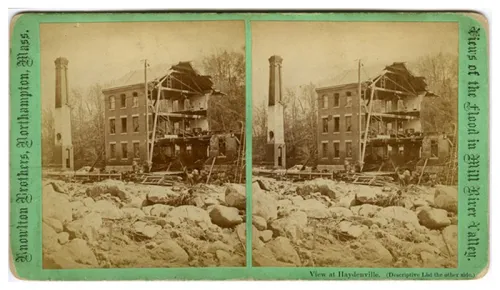
Cheney returned for breakfast to the caretaker’s cabin overlooking the downstream slope with his wife, their five children, and his parents. Cheney’s father, upon getting up from their meal, called out to his son, “For God’s sake, George, look there,” as the east side of the dam sloughed. George Cheney raced to the downstream gatehouse to open the valve. Seepage from the east slope exposed by the slide accelerated, and Cheney feared that the dam would not hold. He bridled his horse, a cheap mare, and rode bareback the 3 miles down the valley to Williamsburg to contact his boss. It was estimated that the initiation of the warning in Williamsburg was 25 minutes after Cheney left the dam and that much of that time was spent convincing Spelman and the livery stable owner of the peril.
Back at the dam, Cheney’s wife, Elizabeth watched. About 20 minutes after George’s departure, she saw the eastern side of the dam finally fail as the slope, in Elizabeth’s words, “seemed to burst all at once, from the bottom, where the earth seemed to be lifted up.” The failure, again in Elizabeth’s words “made an awful noise, like an earthquake.” The sound of the breach was heard by many in the surrounding area as “louder than the biggest clap of thunder.”
The breach widened to about 250 feet, half of the span of the dam, releasing the 2,000 acre-feet of storage from the reservoir into the valley over a period of about one hour. One observer who tried to run ahead of the flood estimated that it took about 20 minutes for the wave to cover the 3 miles and the 300-foot elevation drop from the dam to Williamsburg, a speed of about 9 miles per hour.
George Cheney warned many in Williamsburg but was cut off from riding further downstream by floodwaters. Three other men - Collins Graves, Jerome Hillman, and Myron Day - were able to carry the warnings down the valley.
The flood wave ripped through Williamsburg, Skinnerville, Haydenville, and Leeds and was described as “a great wall about 40 feet high,” probably an exaggeration. Photos of scarred trees suggest a height of 10 to 20 feet for the flood wave. The current, aided by the steepness of the river grade and confined by the narrow valley hills, wrecked the river-hugging villages. The warnings of Cheney, Graves, Hillman, and Day saved hundreds of lives, but not all. The flood killed those who did not hear the warnings, those who could not flee fast enough, those who lingered or tried to save either friends or family in the face of the flood wave, and those unlucky enough to pick the wrong escape route. Below Leeds, the flood wave fell over a steep and short drop to the broad area of Florence meadows, which spread the flood energy over several hundred acres of flat, fertile farmland.
The Aftermath
In total, the failure of the Williamsburg Reservoir Dam took 139 lives, an immense tragedy and the worst fatality toll in this country for a dam failure until the Johnstown flood 15 years later. Forty-three of the dead were children under the age of ten.

Industry and infrastructure in the valley were ruined with losses estimated to exceed $1,000,000 at a time when a mill worker might earn $200 in a year. The population of the valley performed most of the recovery work with funds from outside charity organizations and nearby communities like Northampton. The Legislature did provide significant funds, $120,000, for repair of the roads.
Relief funds were given to those who lost their homes or housing. Homeless families received $300 to reestablish themselves; homeless men received $50, and homeless women received $100 and a trunk with the expectation that they would move elsewhere.
Many of the mill owners rebuilt their factories and had limited success. The valley made do but never returned to its pre-flood prosperity.
The Coroner’s Inquest and the ASCE Investigation
The investigation into the flood was prompt, starting on the fifth day after the flood, when the Hampshire County Coroner convened a jury of six men. The jurors examined the remains of the dam, heard testimony, deliberated, and composed their eight-page verdict, finding fault with all parties – the Massachusetts legislature for not adequately regulating dams, the reservoir company owners for reducing costs at the expense of public safety, the engineers for yielding to the owners’ directions to reduce costs and for not providing thorough inspection of the construction, the contractors for not meeting the specification requirements, and the county commissioners for lack of thoroughness in their inspection. However, in a manner consistent with that era, no one was indicted, and no civil suits were filed.
The relatively new American Society of Civil Engineers (ASCE) independently sent a group of prominent engineers to investigate the dam failure. They reported numerous faults with the design and construction. They noted that the exact cause was uncertain but proposed that foundation underseepage saturated the downstream slope, causing it to slide, leaving the core wall with inadequate support to resist the water load. They proposed “a gradual working out of the gravel under and near the wall, and loose places or cavities formed,” as the failure mechanism.
A more basic conclusion was voiced by one of the ASCE engineers, William Worthen, who said: “Men were employed who were ignorant of the work to be done, and there was nothing like an inspection, although money and life depended upon it. I do not believe, however much we are an evolved species, that we are derived from beavers; a man cannot make a dam by instinct or intuition.”
References:
(1) Sharpe, E. (2004). In the Shadow of the Dam, The Aftermath of the Mill River Flood of 1874. Free Press.
(3) Weber, E. (2004-2006). The Dam; Catastrophe: The Mill River Disaster’s Path in Williamsburg; Williamsburg; Skinnerville; Haydenville; Leeds [Storyboards].
(4) Knowlton Brothers of Northampton. (1874). [Archive stereographic images]. The Williamsburg Historical Society.
(5) Taylor, J.E. (1874). The Massachusetts Flood, Scenes after the Disaster [Sketches]. Frank Leslie’s Illustrated Newspaper.
(6) Davis, T.R. (1874). The Mill River Calamity—Bird’s-Eye View of the Devastated Valley [Sketch]. Harper’s Weekly.
(7) Knowlton Brothers et al. (1874). Mill River Flood Stereographs [Photographs]. Special Collections and University Archives, University of Massachusetts Amherst Libraries.
(8) Massachusetts Legislature, “An Act to Incorporate the Williamsburg Reservoir Company,” Acts of 1865, Chapter 150, April 24, 1865.
(9) County of Hampshire Easement, Simeon Bartlett to Onslow G. Spelman, Trustee, Book 223, page 299, August 4, 1864.
(10) Francis et al. (1874). The Failure of the Dam on the Mill River. American Society of Civil Engineers Transactions Vol. 3.
(11) Wood, Geo. H. (1874). A Full and Graphic Account of the Terrible Mill River Disaster, in Hampshire County, Mass., May 16, 1874, with Full Details of the Loss of Life and Property at Williamsburg, Skinnerville, Haydenville, and Leeds. Springfield, MA: Weaver, Shipman and Company.
(12) The New York Times. (1874-1875). “Mill River Valley, Details of the Great Disaster,” and additional articles concerning the coroner’s inquest.
This case study summary was peer-reviewed by Alon Dominitz, PE, Dam Safety, New York State Department of Environmental Conservation; and William Johnstone, P.E., Spatial Vision Group, Inc.
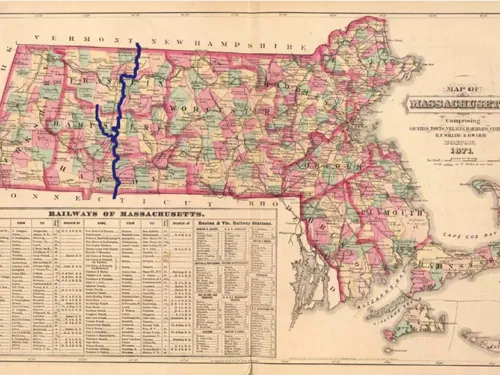

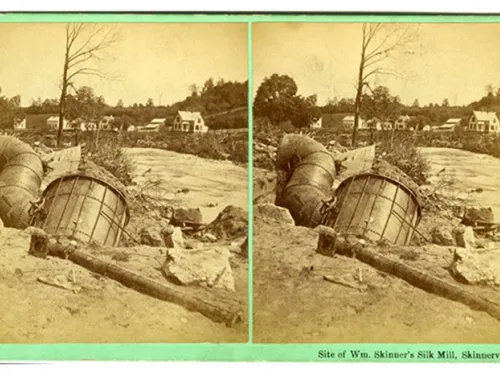

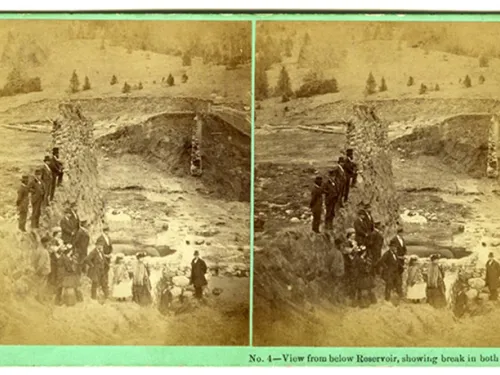

Lessons Learned
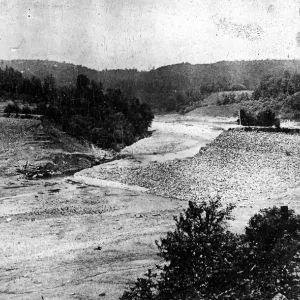
Dam incidents and failures can fundamentally be attributed to human factors.
Learn more
Early Warning Systems can provide real-time information on the health of a dam, conditions during incidents, and advanced warning to evacuate ahead of dam failure flooding.
Learn more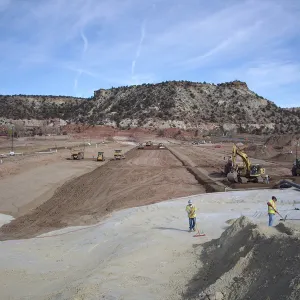
High and significant hazard embankment dams should have internal filter and seepage collection systems.
Learn more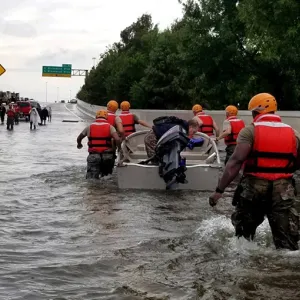
Timely warning and rapid public response are critical to saving lives during a dam emergency.
Learn moreAdditional Lesson Learned Information
- Early Warning Systems (in this case a full-time dam tender) can provide real-time information on the health of a dam, conditions during incidents, and advanced warning to evacuate ahead of dam failure flooding.
- Failure to manage seepage through the dam foundations or embankments using cutoffs, internal filters, and/or seepage collection systems can lead to failures of dams through either internal erosion/piping or slope instability.
- Dams should be designed by engineers with experience in dam design to meet regulatory requirements and state-of-the-practice methods. Those designs should be reviewed by knowledgeable engineers as part of a regulatory oversight.
- Construction of dams and of dam modifications should be monitored by knowledgeable engineers, preferably the designer.

A Guide to Public Alerts and Warnings for Dam and Levee Emergencies
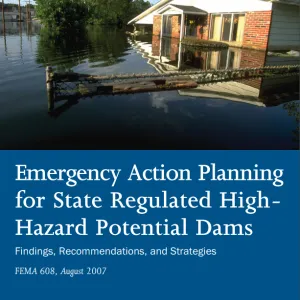
Emergency Action Planning for State Regulated High-Hazard Potential Dams - Findings, Recommendations, and Strategies
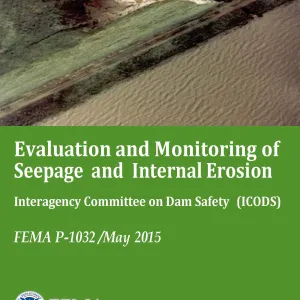
Evaluation and Monitoring of Seepage and Internal Erosion
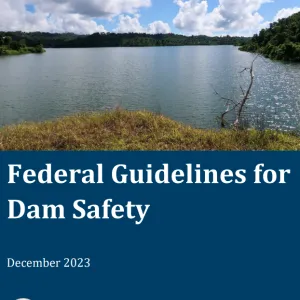
Federal Guidelines for Dam Safety

Federal Guidelines for Dam Safety - Emergency Action Planning for Dams
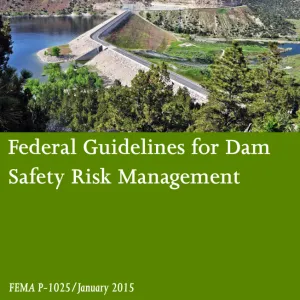
Filters for Embankment Dams
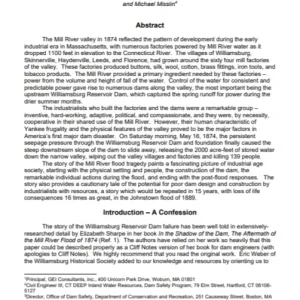
The Williamsburg Reservoir Dam Failure of 1874

